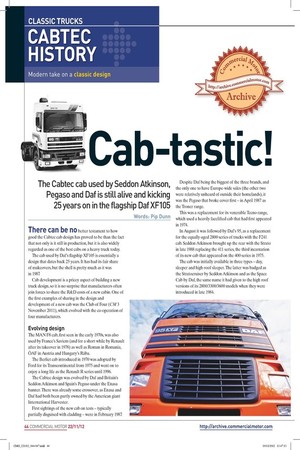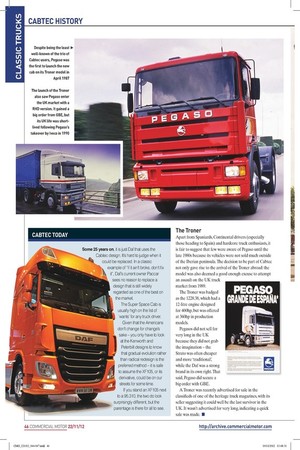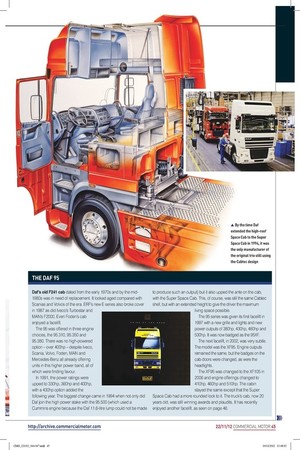Cab-tastic!
Page 35

Page 37

Page 36

Page 38

If you've noticed an error in this article please click here to report it so we can fix it.
The Cabtec cab used by Seddon Atkinson, Pegaso and Daf is still alive and kicking 25 years on in the flagship Daf XF105
Words: Pip Dunn There can be no better testament to how good the Cabtec cab design has proved to be than the fact that not only is it still in production, but it is also widely regarded as one of the best cabs on a heavy truck today.
The cab used by Daf’s flagship XF105 is essentially a design that dates back 25 years. It has had its fair share of makeovers, but the shell is pretty much as it was in 1987.
Cab development is a pricey aspect of building a new truck design, so it is no surprise that manufacturers often join forces to share the R&D costs of a new cabin. One of the first examples of sharing in the design and development of a new cab was the Club of Four (CM 3 November 2011), which evolved with the co-operation of four manufacturers.
Evolving design
The MAN F8 cab, first seen in the early 1970s, was also used by France’s Saviem (and for a short while by Renault after its takeover in 1978) as well as Roman in Romania, ÖAF in Austria and Hungary’s Rába.
The Berliet cab introduced in 1970 was adopted by Ford for its Transcontinental from 1975 and went on to enjoy a long life as the Renault R series until 1996.
The Cabtec design was evolved by Daf and Britain’s Seddon Atkinson and Spain’s Pegaso under the Enasa banner. There was already some crossover, as Enasa and Daf had both been partly owned by the American giant International Harvester.
First sightings of the new cab on tests – typically partially disguised with cladding – were in February 1987. Despite Daf being the biggest of the three brands, and the only one to have Europe-wide sales (the other two were relatively unheard of outside their homelands), it was the Pegaso that broke cover first – in April 1987 as the Troner range.
This was a replacement for its venerable Tecno range, which used a heavily facelifted cab that had first appeared in 1974.
In August it was followed by Daf’s 95, as a replacement for the equally-aged 2800 series of trucks with the F241 cab. Seddon Atkinson brought up the rear with the Strato in late 1988 replacing the 411 series, the third incarnation of its new cab that appeared on the 400 series in 1975.
The cab was initially available in three types – day, sleeper and high-roof sleeper. The latter was badged as the Stratocruiser by Seddon Atkinson and as the Space Cab by Daf, the same name it had given to the high roof versions of its 2800/3300/3600 models when they were introduced in late 1984.
The Troner
Apart from Spaniards, Continental drivers (especially those heading to Spain) and hardcore truck enthusiasts, it is fair to suggest that few were aware of Pegaso until the late 1980s because its vehicles were not sold much outside of the Iberian peninsula. The decision to be part of Cabtec not only gave rise to the arrival of the Troner abroad: the model was also deemed a good enough excuse to attempt an assault on the UK truck market from 1989.
The Troner was badged as the 1228.38, which had a 12-litre engine designed for 400hp, but was offered at 360hp in production models.
Pegasos did not sell for very long in the UK because they did not grab the imagination – the Strato was often cheaper and more ‘traditional’, while the Daf was a strong brand in its own right. That said, Pegaso did secure a big order with GBE.
A Troner was recently advertised for sale in the classifieds of one of the heritage truck magazines, with its seller suggesting it could well be the last survivor in the UK. It wasn’t advertised for very long, indicating a quick sale was made. ■
THE DAF 95
Dall’s old F241 cab dated from the early 1970s and by the mid1980s was in need of replacement. It looked aged compared with Scanias and Volvos of the era. ERF’s new E series also broke cover in 1987 as did Iveco’s Turbostar and MAN’s F2000. Even Foden’s cab enjoyed a facelift.
The 95 was offered in three engine choices, the 95.310, 95.350 and 95.380. There was no high-powered option – over 400hp – despite Iveco, Scania, Volvo, Foden, MAN and Mercedes-Benz all already offering units in this higher power band, all of which were finding favour.
In 1991, the power ratings were upped to 330hp, 360hp and 400hp, with a 430hp option added the following year. The biggest change came in 1994 when not only did Daf join the high power stake with the 95.500 (which used a Cummins engine because the Daf 11.6-litre lump could not be made to produce such an output) but it also upped the ante on the cab, with the Super Space Cab. This, of course, was still the same Cabtec shell, but with an extended height to give the driver the maximum living space possible.
The 95 series was given its first facelift in 1997 with a new grille and lights and new power outputs of 380hp, 430hp, 480hp and 530hp. It was now badged as the 95XF.
The next facelift, in 2002, was very subtle. The model was the XF95. Engine outputs remained the same, but the badges on the cab doors were changed, as were the headlights.
The XF95 was changed to the XF105 in 2006 and engine offerings changed to 410hp, 460hp and 510hp. The cabin stayed the same except that the Super Space Cab had a more rounded look to it. The truck’s cab, now 20 years old, was still winning awards and plaudits. It has recently enjoyed another facelift, as seen on page 46.
Some 25 years on, it is just Daf that uses the Cabtec design. It’s hard to judge when it could be replaced. In a classic example of “if it ain’t broke, don’t fix it”, Daf’s current owner Paccar sees no reason to replace a design that is still widely regarded as one of the best on
the market.
The Super Space Cab is usually high on the list of ‘wants’ for any truck driver.
Given that the Americans don’t change for change’s sake – you only have to look at the Kenworth and Peterbilt designs to know that gradual evolution rather than radical redesign is the preferred method – it is safe to assume the XF105, or its derivative, could be on our streets for some time.
If you stand an XF105 next to a 95.310, the two do look surprisingly different, but the parentage is there for all to see.
THE SEDDON ATKINSON
Seddon Atkinson was a relatively new manufacturer, a merger in the early 1970s between two iconic British manufacturers that were a major part of the home truck scene in the 1960s and into the early 1970s – Seddon and Atkinson.
It was launched with a whole new truck range in 1975, the 200, 300 and 400 series, all of which underwent facelifts as the 201/301/401 in 1980 and the 211/311/411 in 1986.
The Cabtec design replaced the 411, which in fairness was still a pretty modern-looking cab even in 1988. Seddon Atkinson’s reliance on third-party engines meant the Strato could be specified with Cummins or Perkins lumps.
The Strato – and the high-cab Stratocruiser – were badged according to their engines, so there were the 300, 325, 350, 375, 380, 400, 410 and 465 models, which first appeared in 1988.
In 1996 the Strato TC was introduced, a lighter version of the Cabtec cab aimed at sixand eight-wheel chassis and distribution tractors. It was available in day and sleeper cab options.
The Cabtec Seddon Atkinsons had a relatively short life but not because of any particular failings of the cab itself. In 1990, Enasa was sold to Iveco and with a new cab having been devised for the Iveco heavy truck range in 1993, it was a natural development to use this cabin on both Pegaso and Seddon Atkinson.
Still named the Strato, despite looking rather different, the new trucks broke cover in 1994, thus killing off Cabtec Sed Atkis and Pegasos pretty much in one move.










































